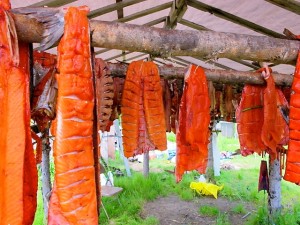Federal staff will again manage king salmon on the lower Kuskokwim River after requests from tribes. Earlier this year, a handful of tribal governments asked the federal subsistence board to implement federal management. The Federal Subsistence Board deferred last month, but at a Friday meeting of the Kuskokwim River Salmon Management Working Group, U.S. Fish and Wildlife Service leaders announced a plan for federal management.

Federal staff plan to limit the chinook fishery to federal qualified users from 32 Kuskokwim villages and manage the fishery day-to-day within the boundaries of the Yukon Delta refuge. U.S. Fish & Wildlife Biologist Brian McCaffery, the in-season manager last year, points to guidance from federal law and the weakened state of king salmon.
“In a time of conservation needs, in resource shortage, if anyone gets a shot at the resources within the conservation unit, it has to be first the federally qualified subsistence users. By implementing the federal special action, we set that sidebar as the bounds for which any harvest can occur,” said McCaffery.
Only residents of the 32 villages would be able to fish for king salmon under federal management. The reason dual management exists is because state and federal law don’t match. While both have subsistence priorities, federal law includes a rural preference the state doesn’t have.
Federal staff managed the king salmon run last summer on federal lands after the Federal Subsistence Board took action on a request from the village of Napaskiak. Five tribal governments asked this year for federal management. The fishery has been in decline for years, and with another poor run expected, Yukon Delta Refuge Manager Neil LaLonde says king salmon fishing may not even be a possibility.
“We expect little to no harvestable surplus,” said LaLonde.
The state estimates the run at 96 to 163-thousand kings, well below the average run of 240-thousand fish. The drainage wide escapement goal range is 65 to 120 thousand kings. LaLonde says his team is still working out management details.
“The season framework itself will likely look very similar to what it was last year in 2014. It wouldn’t be things that would be drastically different. We want to improve on things we did last year and be more effective in different ways,” said LaLonde.
One area to improve is the early season set net fishing. Managers expect to close the river in mid-May to big salmon gear and allow fishing for white fish with four-inch set nets for a period each week, instead of 24/7 fishing like 2014, in which thousands of king salmon were caught.
If there are enough kings for some harvest, LaLonde says it’s too early to say how the harvest would occur. They could implement a limited community permit system or, as the state has proposed, allow a very short king salmon fishing period, with limits on net length, to keep the number of salmon harvested to a minimum.
At a meeting Friday of the Kuskokwim River Salmon Management Working Group, fishermen from the length of the river tried to make sense of what this year’s version of dual management means. Working Group Chair Bev Hoffman emphasized that however it pans out, the goal should be the same for managers and subsistence fishermen.
“We’re going into another year of chinook conservation,” said Hoffman. “Any opportunity, 4” or 6” is not to target chinook for the drying rack.”
Members asked for consistency between federal and state regulations, which could change at Aniak. The state retains management outside of the boundaries of the refuge and the federal action only concerns king salmon. The state has new management options this year that should make it easier to match federal rules, like requiring set nets to be within 100 feet of shore and limited driftnet lengths. State and federal staff emphasized that they plan to work closely this summer and include the working group. The next Working Group meeting is not yet scheduled.
Ben Matheson is a contributor with the Alaska Public Radio Network.




